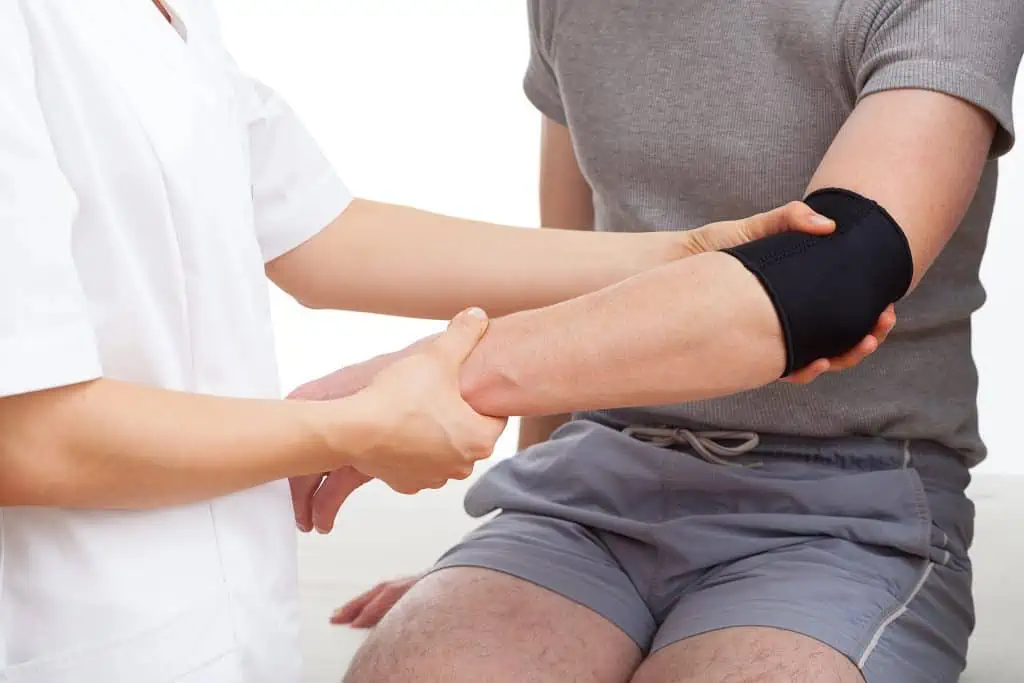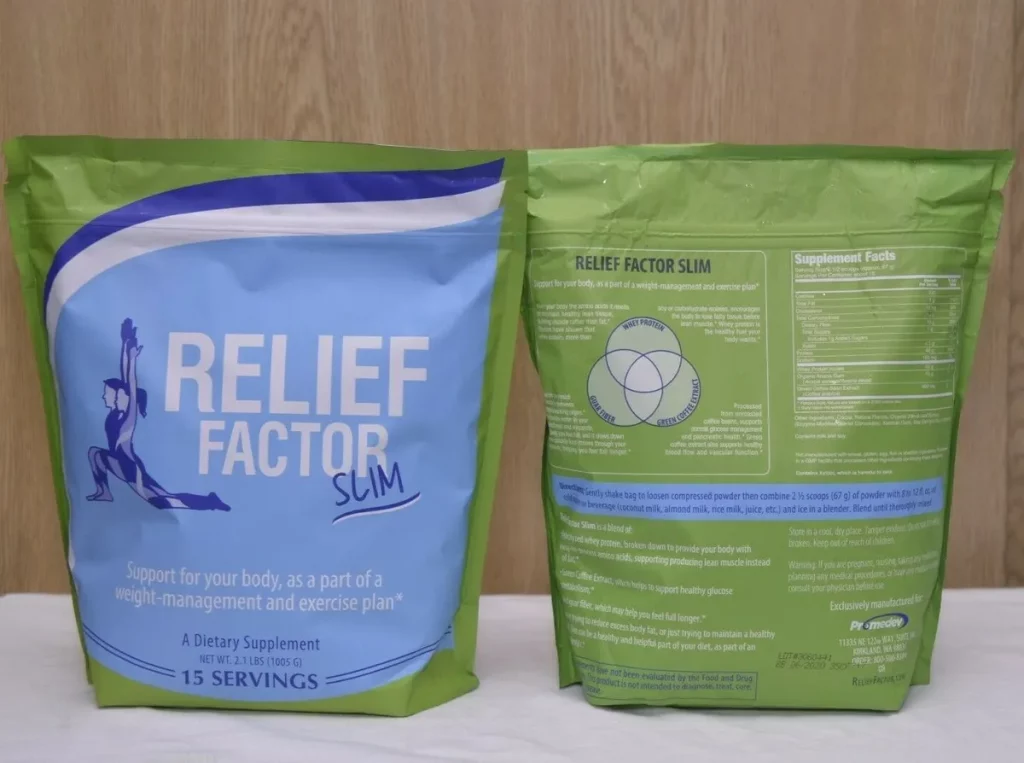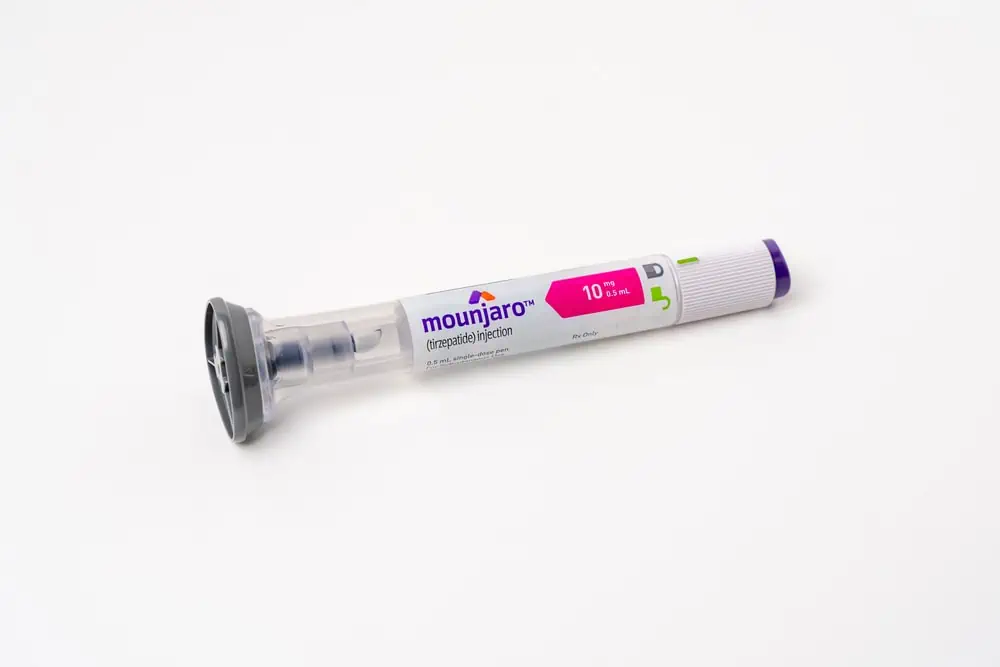Are you experiencing radiating pain from shoulder to elbow, limiting your daily activities and causing discomfort? Understanding the causes, common symptoms, and available treatment options is crucial for managing this pain effectively and regaining your freedom of movement. In this blog post, we’ll explore the various types of shoulder and elbow injuries, how they can be diagnosed, and the best methods for prevention and treatment.
Key Takeaways
- Identifying radiating shoulder and elbow pain requires recognizing symptoms, causes, and injuries.
- Treatment options include conservative treatments, physical therapy exercises & stretches, as well as surgical interventions.
- Preventive measures such as proper technique in activities & regular exercise can help avoid injury or discomfort. Seek medical attention if symptoms persist or worsen.
Identifying Radiating Pain from Shoulder to Elbow
Radiating pain from shoulder to elbow can have a significant impact on your quality of life, making it difficult to perform everyday tasks and engage in physical activities. So, pinpointing the symptoms and causes of this discomfort becomes a necessary step towards devising an effective treatment strategy.
Possible causes include overuse, injuries, and chronic conditions affecting the upper arm bone. Recognizing these symptoms and procuring the right treatment can help mitigate the pain and reinstate normal operation.
Common Symptoms
One of the first steps towards managing shoulder pain, as well as shoulder and elbow pain, is recognizing the common symptoms of elbow pain shoulder. These may include:
- Mild pain present during both activity and rest
- Pain radiating from the front of the shoulder to the side of the arm
- Muscular soreness, which can sometimes be caused by a pinched nerve
- Tenderness, swelling, and discomfort in the affected area
Paying heed to these symptoms is vital as they can offer insightful details about the root cause of your discomfort. For example, conditions such as subacromial bursitis, bicipital tendinitis, and rotator cuff tendinitis could cause pain due to overuse, injuries, or chronic conditions affecting the tendons in the shoulder and elbow. Recognizing your specific symptoms streamlines understanding potential causes and facilitates the search for suitable treatment.
Potential Causes
Several potential causes can contribute to radiating pain from shoulder to elbow. Some of the most common include:
- Rotator cuff injuries: damage to the muscles and tendons surrounding the shoulder joint, often caused by overuse or trauma.
- Tendonitis: inflammation of a tendon, typically resulting from overuse.
- Nerve compression: pressure on a nerve, which can cause pain to radiate from the shoulder to the elbow.
Nerve compression can also be a significant cause of shoulder and elbow pain. It can be attributed to injury, repetitive motions, or overuse. Understanding the potential reasons for your pain enables you to collaborate with a healthcare professional, crafting a focused treatment plan that tackles the particular issues causing your discomfort.
Types of Shoulder and Elbow Injuries
Shoulder and elbow injuries can be broadly categorized into shoulder injuries, including rotator cuff injuries, and elbow injuries, each with their specific causes and symptoms. Comprehending the variety of injuries that can impact these joints is a key aspect of deciding on the suitable treatment strategy.
In the following sections, we will delve into the details of both rotator cuff injuries and elbow injuries, exploring their causes, symptoms, and potential treatment options.
Rotator Cuff Injuries
Rotator cuff injuries involve damage to the muscles and tendons that surround the shoulder joint, playing a crucial role in stabilizing the humerus within the shoulder joint. These injuries can be caused by both injury and degeneration. Traumatic events, such as falling on an outstretched arm or lifting a heavy object, can lead to sudden injury, while age-related wear and tear can cause degeneration over time.
The indications of a torn rotator cuff may include:
- Difficulty in lifting and maneuvering the arm
- Shoulder discomfort
- Decreased strength in the arm
- Clicking or popping sounds when moving the arm
Experiencing these symptoms warrants consultation with a healthcare professional for precise diagnosis and fitting treatment suggestions.

Elbow Injuries
Elbow injuries, such as tennis elbow or golfer’s elbow, are often caused by repetitive motions and overuse of the forearm muscles. While these conditions are commonly associated with their respective sports, they can affect anyone regardless of their athletic pursuits. Tennis elbow is characterized by pain and tenderness on the outer side of the elbow that can extend to the forearm, whereas golfer’s elbow is identified by pain and tenderness on the inner side of the elbow that can also extend to the forearm.
Diagnosis for these types of elbow injuries typically involves a physical examination and evaluation of symptoms. Treatment options may include rest, over-the-counter pain medications, ice application, physical therapy exercises, wearing a brace, and corticosteroid injections in some cases.
Grasping the causes and symptoms of elbow injuries allows you to take fitting steps towards managing your discomfort and warding off additional complications.
Diagnosing Radiating Pain from Shoulder to Elbow
Diagnosing radiating pain from shoulder to elbow is a critical step in developing an effective treatment plan. This process typically involves a physical examination by a healthcare professional, which may include:
- Inspection
- Palpation
- Evaluation of range of motion
- Provocative testing
In some cases, imaging tests such as X-rays, CT scans, or MRI may also be necessary for a more accurate diagnosis.
In the following sections, we will discuss the details of physical examination and imaging tests used in diagnosing shoulder and elbow pain.
Physical Examination
Physical examination proves crucial in diagnosing shoulder and elbow discomfort and deciding on the optimal treatment course. During the examination, a healthcare professional will assess:
- Your range of motion
- Your strength
- Your pain levels in the affected area
- Inspection
- Palpation
- Provocative testing
These evaluations are typically performed to identify any abnormalities or injuries that may be causing your pain.
Examining your shoulder’s movement in multiple directions and evaluating your strength via tests like Neer’s test, the, and Jobe’s Test, provides a healthcare professional with a comprehensive grasp of your symptoms and their likely causes. This information will then be used to guide your treatment plan, ensuring that it is tailored to your specific needs and addressing the root cause of your pain.
Imaging Tests
In some cases, imaging tests such as X-rays, MRI, or ultrasound may be necessary to further investigate the cause of your shoulder and elbow pain. These tests can provide detailed images of the structures in the shoulder and elbow region, helping to identify injuries or abnormalities in:
- Bones
- Muscles
- Tendons
- Ligaments
- Other soft tissues
that may be causing the radiating pain.
MRI scans, in particular, are valuable for diagnosing radiating pain from shoulder to elbow, as they can detect conditions such as fractures, rotator cuff tears, labrum tears, and other structural abnormalities that may be contributing to the pain. Additionally, MRI is useful for evaluating the extent and location of the problem, guiding treatment decisions, and determining the need for surgery in some cases.
Merging the results of a physical examination with imaging tests enables healthcare professionals to acquire an all-encompassing understanding of your condition and recommend the most potent treatment alternatives.

Treatment Options for Radiating Pain from Shoulder to Elbow
Once the cause of your shoulder and elbow pain has been identified, a range of treatment options may be available to help alleviate your discomfort and restore normal function. These options can include conservative treatments, physical therapy, and surgical interventions, depending on the severity and cause of your pain.
In the following sections, we’ll explore each of these treatment options in more detail, discussing their benefits and potential effectiveness in addressing your specific needs.
Conservative Treatments
Conservative treatments are often the first line of defense when it comes to managing shoulder and elbow pain. These treatments may include:
- Rest
- Ice
- Compression
- Elevation (RICE)
The RICE method is a self-care technique that can help reduce swelling, relieve pain, and facilitate healing. Over-the-counter pain relievers, such as acetaminophen (Tylenol), ibuprofen (Advil, Motrin), and naproxen (Aleve), can also help alleviate discomfort and reduce inflammation.
In addition to RICE and over-the-counter medications, conservative treatments may also include the use of non-steroidal anti-inflammatory drugs (NSAIDs) to reduce inflammation and alleviate joint pain. Incorporating these conservative treatments into your pain management strategy effectively tackles your shoulder and elbow discomfort, thus kickstarting the healing process.
Physical Therapy
Physical therapy can be a highly effective treatment option for shoulder and elbow pain, as it helps to improve strength, flexibility, and range of motion in the affected area. Through targeted exercises and stretches, physical therapy can reduce pain and prevent future injuries by addressing the underlying issues contributing to your discomfort. Some of the most effective exercises and stretches for shoulder and elbow pain prevention include:
- Shoulder blade squeeze
- Across-the-chest stretch
- Arm swings
- Wrist extension and flexion stretches
- Elbow bend and wrist turn
The frequency of physical therapy for radiating pain from shoulder to elbow should be determined by a healthcare professional, as it may vary depending on the severity of your condition and your individual requirements. Working in close collaboration with a physical therapist enables you to develop a personalized treatment plan that caters to your unique needs, helping you regain strength and mobility in your shoulder and elbow joints.

Surgical Interventions
In some cases, surgical interventions may be necessary to treat shoulder and elbow pain, particularly when conservative treatments and physical therapy have not provided relief. Surgical options for severe injuries or cases where nonsurgical treatments have not been successful can include:
- Decompressing the subacromial space
- Capsular release and arthroscopic debridement
- Hemiarthroplasty
- Total shoulder arthroplasty
The decision for surgery ultimately depends on the specific condition and the severity of the symptoms.
Surgery, including shoulder surgery, can be particularly beneficial for individuals with arthritic shoulders who were previously only eligible for total shoulder replacement, as it preserves the bone in the shoulder and ensures a secure fit for the new bone to integrate with the implant for those in the early stages of arthritis. Consulting with a healthcare professional and weighing all available treatment options enables you to determine the most suitable course of action for your shoulder and elbow discomfort.
Preventing Shoulder and Elbow Pain
Preventing shoulder and elbow discomfort is not only crucial for preserving your overall health and well-being, but it also aids in reducing the risk of future injuries. Practicing proper technique during physical activities, as well as incorporating regular exercise and stretching into your routine, can help keep your shoulder and elbow joints healthy and pain-free.
In the following sections, we’ll explore the importance of proper technique and the benefits of regular exercise and stretching for the prevention of shoulder and elbow pain.
Proper Technique
Proper technique is crucial for reducing the risk of injury and pain in the shoulder and elbow during sports and other physical activities. For example, when lifting heavy objects, it is important to hold the items close to your body, bend your knees and keep your back upright, stand close to the object, avoid lifting above shoulder level, and avoid jerking or sudden movements. Additionally, maintaining good posture when using a computer can help prevent shoulder and elbow pain by reducing strain on the muscles and joints.
Certain sports, such as tennis and golf, also require proper technique to prevent shoulder and elbow injuries. Emphasizing proper form during swings, internal rotation of the upper arm at the shoulder, trunk rotations in the serve, and lower limb and pelvic drive in groundstrokes can help reduce the risk of injury.
Practicing proper technique and form during physical activities helps in minimizing the risk of shoulder and elbow discomfort while maintaining healthy joints.
Regular Exercise and Stretching
Incorporating regular exercise and stretching into your routine can help maintain strength and flexibility in the muscles and tendons surrounding the shoulder and elbow, reducing the risk of injury and pain. Engaging in regular exercise and stretching can preserve strength, enhance flexibility, and improve range of motion in the affected area, thereby reducing the likelihood of injury and pain. Exercises and stretches for shoulder and elbow pain prevention include Eagle arms spinal rolls, Pendulum stretch, and Shoulder rolls.
It is recommended to exercise and stretch 2 to 3 times a day in order to prevent shoulder and elbow pain. For exercises, aim to do 2 to 3 sets of movements and stretches. Additionally, incorporating shoulder-strengthening exercises 1-2 times per week can help keep the shoulders strong and pain-free. Prioritizing regular exercise and stretching effectively aids in preventing shoulder and elbow discomfort while maintaining healthy joints.

When to Seek Medical Help
It’s crucial to know when to seek medical help for shoulder or elbow pain. Persisting pain for several weeks, worsening discomfort, or severe symptoms such as numbness, tingling, or loss of strength necessitate a consultation with a healthcare professional. Early intervention can lead to more effective treatment and better outcomes, so don’t hesitate to seek help if you’re concerned about your shoulder or elbow pain.
Severe pain, swelling, deformity, inability to move the arm, and arm pain accompanied by fever or visible deformity are all symptoms that require immediate medical evaluation. Furthermore, if your discomfort doesn’t improve with home remedies or lingers for more than a few weeks, consulting a medical professional for further assessment and treatment becomes imperative.
Summary
In conclusion, understanding the causes, symptoms, and available treatment options for radiating pain from shoulder to elbow is essential for managing this discomfort and regaining your freedom of movement. By identifying the specific causes of your pain, seeking appropriate treatment, and incorporating preventive measures such as proper technique and regular exercise and stretching, you can alleviate your pain and maintain healthy shoulder and elbow joints. Don’t let shoulder and elbow pain hold you back – take control of your health and embrace a pain-free future.
Frequently Asked Questions
What causes shoulder pain that radiates down to elbow?
Subacromial bursitis, caused by overuse of the rotator cuff muscles, is a common cause of shoulder pain that radiates down to the elbow. Rotator cuff disease can also lead to this type of pain from the shoulder to the upper arm and elbow.
How do you relieve shoulder pain from down to elbow?
To relieve shoulder pain down to the elbow, use the R.I.C.E. method (Rest, Ice, Compression, and Elevation) in combination with over-the-counter anti-inflammatory medications, such as ibuprofen or naproxen sodium, for short-term relief. Strengthening and stretching the supporting muscles may also help prevent further injury.
What are 2 warning signs of a rotator cuff tear?
Two common warning signs of a rotator cuff tear are difficulty in raising, lowering or rotating the arm, and pain and weakness in that arm. Additionally, popping, clicking or crackling sounds may be heard when moving the arm in certain positions.
How can I prevent shoulder and elbow pain?
To prevent shoulder and elbow pain, practice proper technique when exercising, make stretching a regular part of your routine, and maintain good posture.
What conservative treatments are available for shoulder and elbow pain?
Conservative treatments for shoulder and elbow pain such as rest, ice, compression, elevation, over-the-counter pain relievers and anti-inflammatory medications can help reduce discomfort and promote healing.












